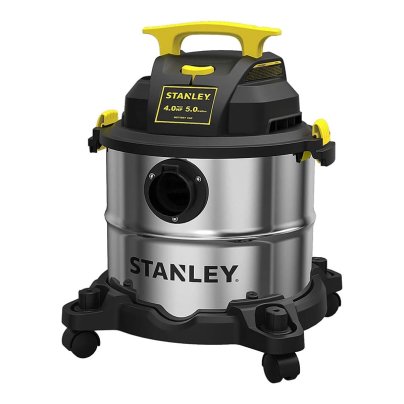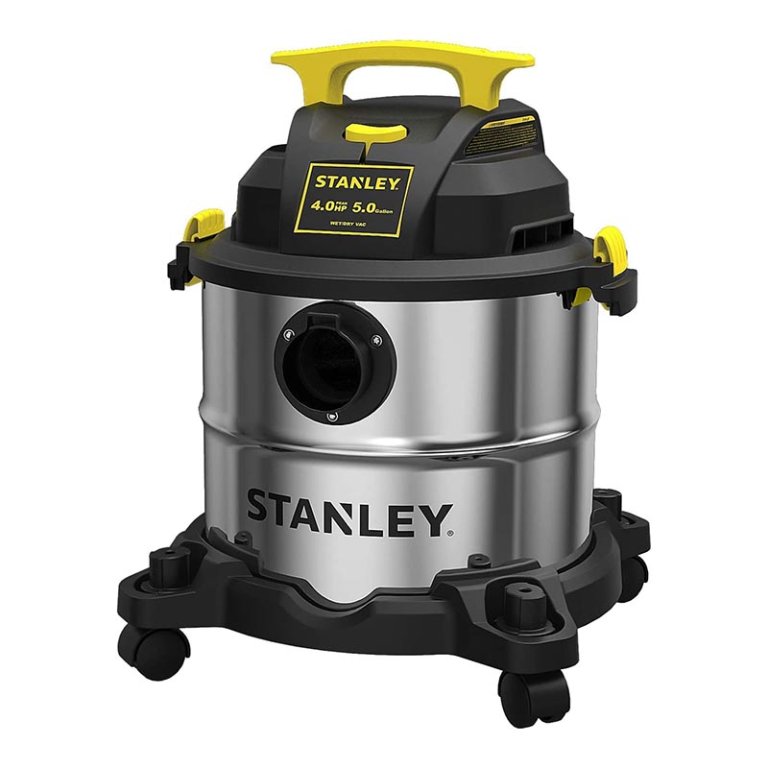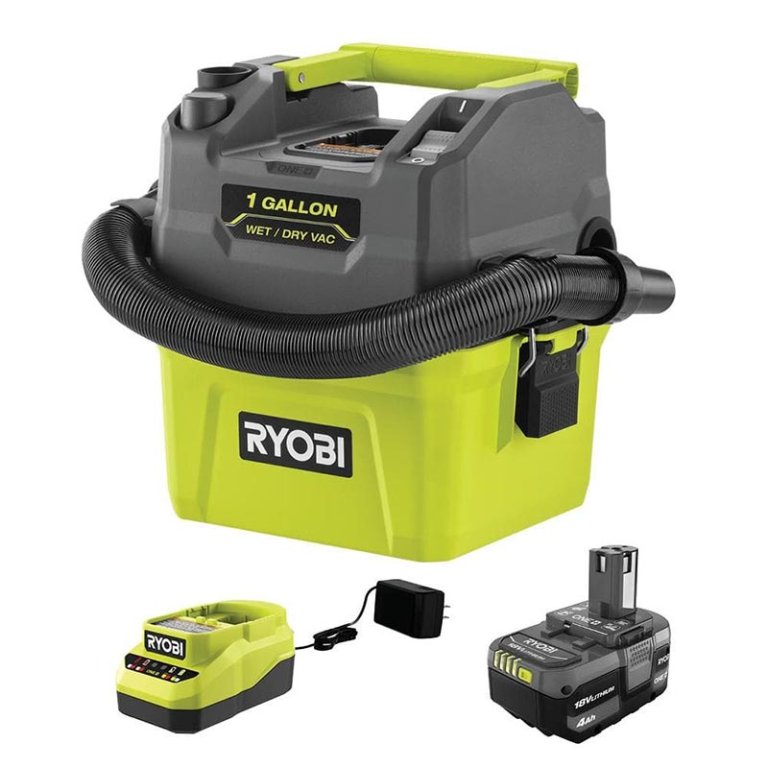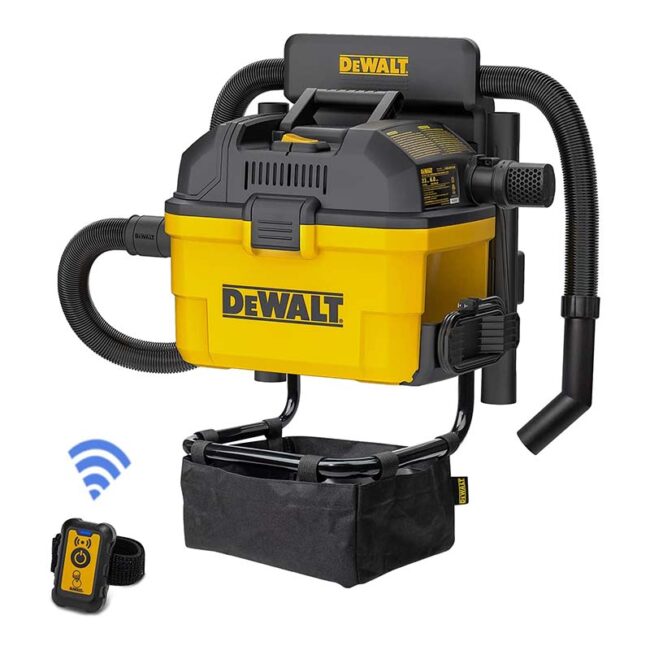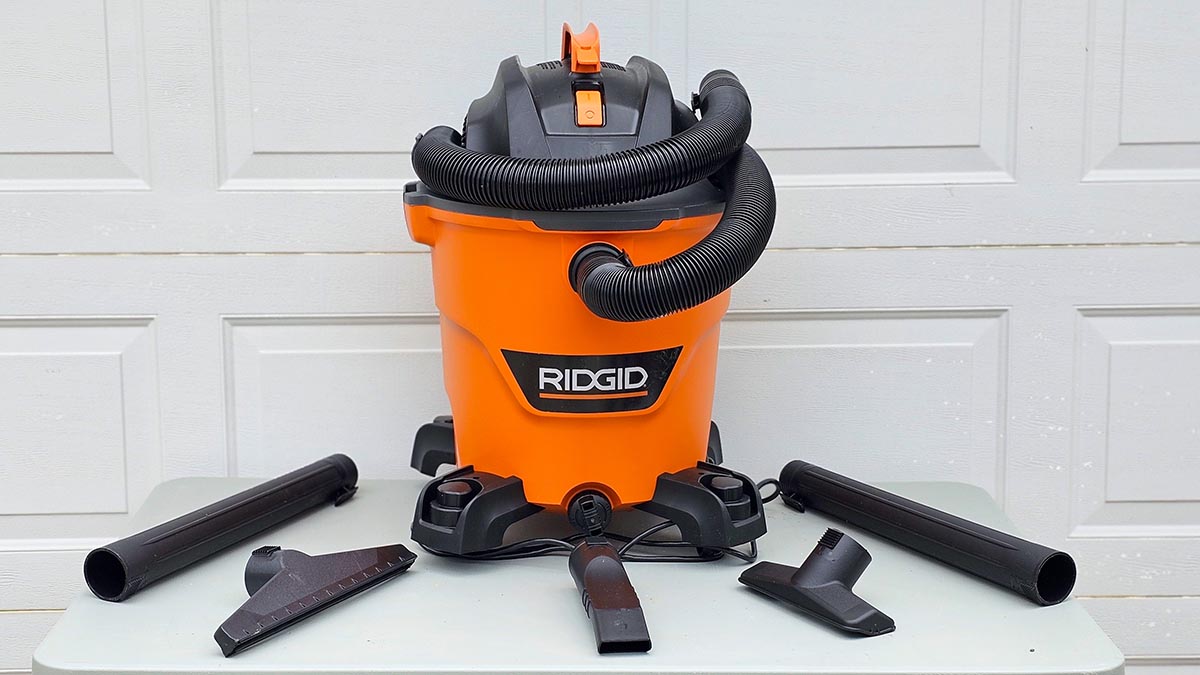
We may earn revenue from the products available on this page and participate in affiliate programs. Learn More ›
‘Shop vacs’, also known as wet/dry vacs, are designed to clean up after workshop, around-the-house, and DIY projects. More versatile than a household vacuum, they can clean up wet sawdust and even suction water.
Since many of our projects regularly create big messes, we decided to test today’s best-selling models in our own shops and garages. We researched over 25 models before settling on the highest-rated five for hands-on testing. All five scored well, but we found a favorite—a 12-gallon corded Ridgid shop vac that demonstrated unbeatable suction and came with several handy accessories.
Shop vacuums are simple cleaning tools—there’s not much to them. But before buying, check out our guide below to help determine the best type for your needs and see what an expert we interviewed has to say. Also, find out how the following models earned a spot in this lineup of the best shop vacs.
- BEST OVERALL: Ridgid 12-Gallon 5.0 Peak HP NXT Wet/Dry Shop Vacuum
↓ Jump to Review - BEST BANG FOR THE BUCK: Stanley 5-Gallon 4 Peak MAX HP Pro SS Wet/Dry Vacuum
↓ Jump to Review - BEST BATTERY-POWERED: Milwaukee 6-Gallon M18 Fuel Wet/Dry Shop Vacuum
↓ Jump to Review - BEST COMPACT PICK: Ryobi 18V One+ 1-Gallon Wet/Dry Shop Vacuum Kit
↓ Jump to Review - BEST LARGE-CAPACITY: DeWalt 9-Gallon 5 HP Wet/Dry Shop Vacuum
↓ Jump to Review - BEST MULTI-USE: DeWalt 6-Gallon 5 HP Wall-Mounted Wet/Dry Vac
↓ Jump to Review
| Testing Stats | |
| Products tested | 5 |
| Time spent testing | 5 hours |
| Tests performed | 3 |
| Price range | $85 to $450 |
Our Top Picks
Just ahead you’ll find some of the top-performing shop-type vacuums available today. Some have large-capacity bins, while others are compact and more portable. We also included corded and battery-powered shop vac options. No matter what type of projects you tackle, you’ll find a vacuum that will make for a quick cleanup afterward.
Best Overall
Ridgid 12-Gallon 5.0 Peak HP NXT Wet/Dry Shop Vacuum
What We Like
- Powerful 5 hp motor for quick cleanups
- Large 12-gallon capacity for big messes
- Efficient wet-and-dry mess cleanup
- Good pick for professional or jobsite use
What We Don’t Like
- Large size requires more storage space
Product Specs
- Power type: Corded
- Drum capacity: 12 gallons
- Peak horsepower: 5 horsepower (hp)
- Attachments: Hose, 2 extension wands, utility nozzle, wet nozzle, car nozzle
Our Ratings: Ease of Use 5/5; Performance 5/5; Portability 4.3/5; Value 4.8/5
If you make big messes (like we do), you need a powerful large-capacity shop-type vacuum. The Ridgid made quick work of sucking up both wet and dry messes in our tests. It comes with a 7-foot heavy-duty locking hose and a 15-foot cord, so we had plenty of reach between the outlet and the mess we were cleaning.
We poured water on a garage floor and used the wet nozzle to suck it up. The wet nozzle features a squeegee on the bottom, making wet cleanups a breeze. This is the vacuum we wish we’d had when our basement was flooding—it would have stayed ahead of the water that was leaking in. Plus, it has a handy drain plug in front that makes it easy to release the water without having to tip the canister.
The Ridgid 12-gallon vac isn’t a compact model, standing 26.6 inches high with an 18.7-inch diameter. However, if you need professional cleaning power, it’s just the thing.
Get the Ridgid shop vac at The Home Depot.
Best Bang for the Buck
Stanley 5-Gallon 4 Peak MAX HP Pro SS Wet/Dry Vacuum
What We Like
- Great value without a high price point
- Can be used as a vacuum or a leaf blower
- Effectively handles wet and dry debris
- Compact size makes it suitable for small shops
What We Don’t Like
- Lacks a drain plug
Product Specs
- Power type: Corded
- Drum capacity: 5 gallons
- Peak horsepower: 4 hp
- Attachments: Brush, crevice tool, extension wand, filter, hose
Our Ratings: Ease of Use 5/5; Performance 4.8/5; Portability 5/5; Value 4.8/5
You can get a great wet and dry shop vac without spending a lot of money. The Stanley 5-gallon shop-type vacuum features a sleek stainless steel canister, caster wheels, and a rear blower port. When its hose is attached to the blower port, it delivers up to 85 cubic feet of air per minute (CFM), so we were able to use it as a leaf blower in addition to a vacuum.
It has a 10-foot electrical cord and a 5-foot hose. While that’s not as much reach as some models we tested, it’s likely enough for most shop-type cleanups. It did a great job of sucking up sawdust, wet and dry leaves, and vacuuming standing water. The downside, and it’s not a significant one, is that it doesn’t come with a drain plug at the bottom of the tank, so it has to be manually tipped over to drain. But that’s not too difficult, and the price of this little powerhouse is just right for a machine that’s suited for small workshops and around-the-house use.
Get the Stanley shop vac at Amazon, The Home Depot, or Zoro Tools.
Best Battery-Powered
Milwaukee 6-Gallon M18 Fuel Wet/Dry Shop Vacuum
What We Like
- Battery-powered, cordless convenience
- Rapid charger recharges battery quickly
- Snap-on roller base adds to portability
- High-capacity battery and charger included
What We Don’t Like
- Recharging is necessary for consistent power
Product Specs
- Power type: Battery
- Drum capacity: 6 gallons
- Peak horsepower: N/A
- Attachments: Crevice tool, utility nozzle, filter, hose, 2 extension wands
Our Ratings: Ease of Use 5/5; Performance 4.8/5; Portability 5/5; Value 4.8/5
Milwaukee does it again! This high-end tool manufacturer took a simple shop-type vacuum and turned it into a well-designed cleanup tool that can be used anywhere, even when an electrical outlet isn’t available.
This battery-powered industrial shop vac doesn’t lack power. It comes with a high-capacity 8-amp-hour (Ah) rechargeable battery and a rapid charger—and rapid is right! We figured it would take 3 to 4 hours to charge this powerful battery fully, but an hour after we put it on the charger, it was ready to go.
This Milwaukee shop vacuum has several great perks. Since it’s cordless, we were able to transport it to a very remote spot and use it to vacuum up piles of bonfire ash and debris. It also excelled in our water-removal tests, although we felt the floor nozzle would have been quicker at sucking up the water if it had a squeegee on the bottom. Still, it performed very well.
While this vacuum weighs 26 pounds, we gave it extra points for portability thanks to a snap-on base that rolls smoothly on caster wheels. When we wanted to remove the tank from the base, all we had to do was step on a foot release and lift it off. This is a quality wet/dry vacuum, and being cordless boosts it to a whole new level.
Get the Milwaukee shop vac at The Home Depot (tool only), Ace Hardware, Northern Tool + Equipment, SupplyHouse.com, or Grainger.
Best Compact Pick
Ryobi 18V One+ 1-Gallon Wet/Dry Shop Vacuum Kit
What We Like
- Compact; easy to store and transport
- Suitable for both wet and dry use
- Eliminates the need to be near an electrical outlet
- Highly portable shop vac
What We Don’t Like
- No floor attachment
- May not be suitable for heavy-duty cleanups
Product Specs
- Power type: Battery
- Drum capacity: 1 gallon
- Peak horsepower: N/A
- Attachments: Crevice tool, filter, hose
Our Ratings: Ease of Use 4.8/5; Performance 4.8/5; Portability 5/5; Value 5/5
Cleaning up small messes is no problem with Ryobi’s 1-gallon battery-operated shop vac. This little shop sucker is tiny in size but long on power. It took almost 2 hours to charge the included 4 Ah battery fully, but we tested it for over an hour, and it was still sucking powerfully when we finished testing.
The Ryobi sucks up water, but it doesn’t come with a wet-floor attachment, so it’s better suited to directly removing excess water from containers, such as sump pump buckets and the like. We thought it was best suited to small dust jobs and perhaps as a travel vac given that it weighs only 7 pounds and is 11.75 inches tall by 14.5 inches wide by 10.75 inches deep. It’s lightweight and fits well in most car trunks.
It was a little slower to vacuum up heavy debris, but that’s to be expected. For its size and power, the Ryobi is hard to beat for those looking for a compact shop-type vac that won’t take up a lot of real estate in a garage or storage shed.
Get the Ryobi shop vac at The Home Depot.
Best Large-Capacity
DeWalt 9-Gallon 5 HP Wet/Dry Shop Vacuum
What We Like
- Efficient at sucking up wet and dry messes
- Large-capacity tank for big jobs
- Drain plug makes draining water easy
- Durable build quality
What We Don’t Like
- Caster wheel could roll more smoothly
Product Specs
- Power type: Corded
- Drum capacity: 9 gallons
- Peak horsepower: 5 hp
- Attachments: 2 extension wands, washable filter, floor nozzle, utility nozzle, crevice nozzle, disposable filter bag, and accessory storage bag
Our Ratings: Ease of Use 5/5; Performance 4.8/5; Portability 4/5; Value 5/5
Sucking up seeping water from the floor is no problem with this DeWalt 9-gallon shop vacuum. It features 5 hp and comes with a floor nozzle that picks up standing water with ease. Its two extension wands allowed us to stand comfortably without needing to bend over to suck up water. It also has a drain plug that makes it easy to dump the large-capacity tank when it’s full of water.
We love the DeWalt brand, and this shop-type vacuum is one of the reasons. It’s powerful, built to last, and gets right down to business. The large tank also makes it well suited to jobsite use, and the included fine-dust shop vac filter allowed us to vacuum up piles of drywall compound dust without recirculating it in the air.
If we could do one thing differently, we’d make the caster wheels roll more smoothly. They’re not bad, but we have a habit of pulling our shop vacuums along by their hoses, and to do that, the wheels need to roll as smooth as butter.
Overall, however, this is our pick for busy workshops and jobsites, plus it’s a great vac to have on hand if your home is prone to occasional flooding.
Get the DeWalt shop vac at Amazon, Lowe’s, or The Home Depot.
Best Multi-Use
DeWalt 6-Gallon 5 HP Wall-Mounted Wet/Dry Vac
What We Like
- Comes with a remote control for turning the model on and off from your workstation
- Clever onboard storage and wall-mounted rack keep everything neatly organized
- Provides plenty of power for a compact vacuum and comes with multiple accessories
What We Don’t Like
- Due to its compact size, it’s not ideal for large messes
Product Specs
- Style: Shop style
- Power: 5 horsepower (hp)
- Size: 6 gallons
This Bob Vila Approved product carries our brand’s highest level of recommendation.

Bob Vila Approved recognizes the household and DIY products that impressed us most in our real-world testing and that exemplify core values of the Bob Vila brand, including craftsmanship, innovation, and value for the dollar. Winners of this designation come recommended by our professional review team and are personally approved by Bob Vila.
Folks looking for a top-notch wet/dry vacuum will seriously want to consider the DeWalt 6-gallon 5-hp wall-mounted wet/dry vac. While larger and more powerful models are available, this unit has upgraded features that make a serious difference, including a super-flexible hose and remote control that turns the model on and off from your workstation.
This DeWalt wet/dry vac also comes with lots of accessories. You get a wall-mounted rack for the vac and its attachments as well as extensions, a claw nozzle, a crevice nozzle, a round brush, a utility nozzle, a floor nozzle, several filters, a bag, and even a muffler. The 5-hp motor has plenty of power for almost all cleanup activities, and while the 6-gallon canister might be small for jobsites or big floods, it’s compact enough for garage use.
The difference between this hose and all the other hoses we tested was night and day. This model’s hose was flexible and soft as well as thick and heavy-duty. Also, turning this wet/dry vac on and off from a remote is incredibly handy, especially when cleaning a car or tidying up around an entire garage. It had more than enough power for our purposes, though we did find that, due to its compact size, it’s not ideal for large spills or really big jobs, and it also doesn’t have wheels.
It’s worth noting that between the onboard storage and the mounting rack, all of the accessories and the hose store neatly away. And, since the rack is designed to hang from just one stud, we found that it’s much easier to install than its size would imply.
Read our full review: DeWalt 6-Gallon 5 HP Wall-Mounted Wet/Dry Vac
Get the DeWalt wall-mounted wet/dry vacuum at Amazon, Lowe’s, Tractor Supply Co., or The Home Depot.
Jump to Our Top Picks
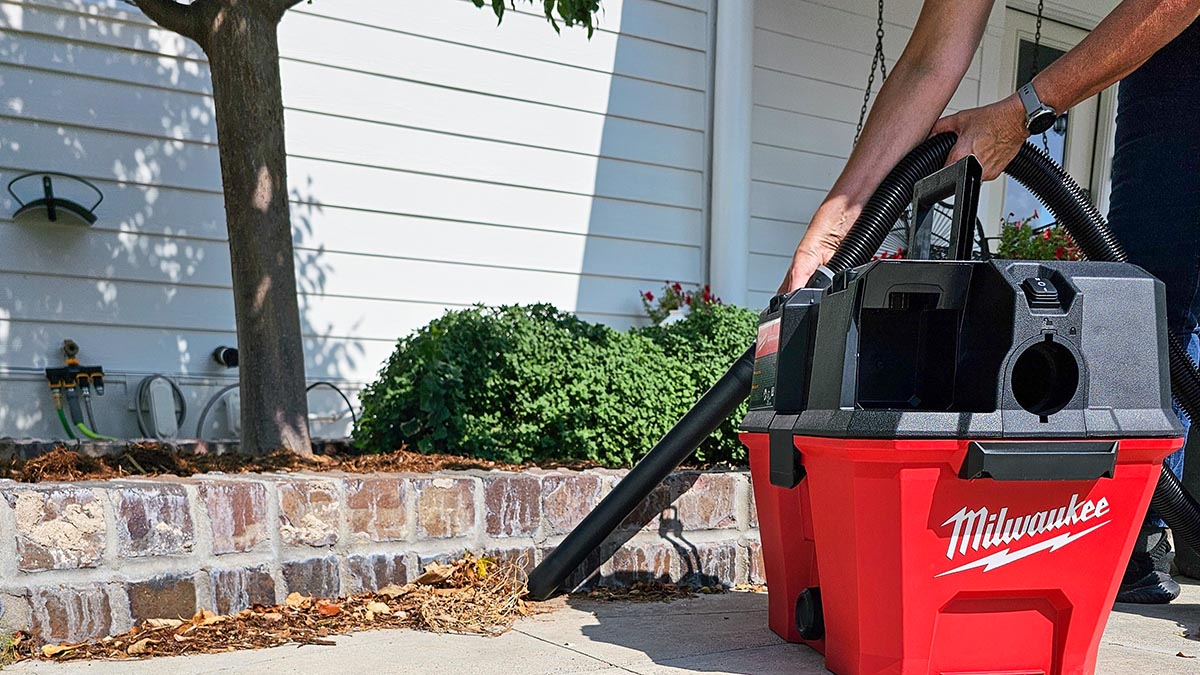
How We Tested the Best Shop Vacs
Before getting our hands on the vacuums, we spoke to Ronnie Kendrick, founder of CompanyClean, a house-cleaning service in Highlands Ranch, Colorado. He says tank capacity is the most important aspect to consider, while attachments shouldn’t necessarily be something to worry about: “In the years of using wet/dry vacuums, we’ve never needed to use any attachments because the primary use is on hardwood floors. These get into the corners and edges quite well. If we need an attachment, we’ll use a standard vacuum cleaner instead.” Regarding tank capacity, he says that if you have a large home, you might be refilling the tank more often than you would expect. “In a 300-square-foot kitchen, we usually have to empty the tank and refill it at least once.” Keeping these details in mind, we set out to choose our top picks for testing.
In choosing the vacuums for testing, we considered several factors. We looked at the model’s power specs, tank capacity, power type (corded or cordless), and whether it came with useful attachments. We considered brand to an extent; after all, manufacturers like DeWalt and Milwaukee have impeccable product reputations. We also looked at customer ratings because that’s the ultimate litmus test.
Testing was straightforward. We used the vacuums to clean up wet and dry messes, including water on a level surface, water in a bucket, damp and dry sawdust, and even leaf and lawn debris. Each vacuum was awarded points based on its performance on a test or assessment. After testing, we averaged the points to determine our top pick and categorize the others according to their best uses.
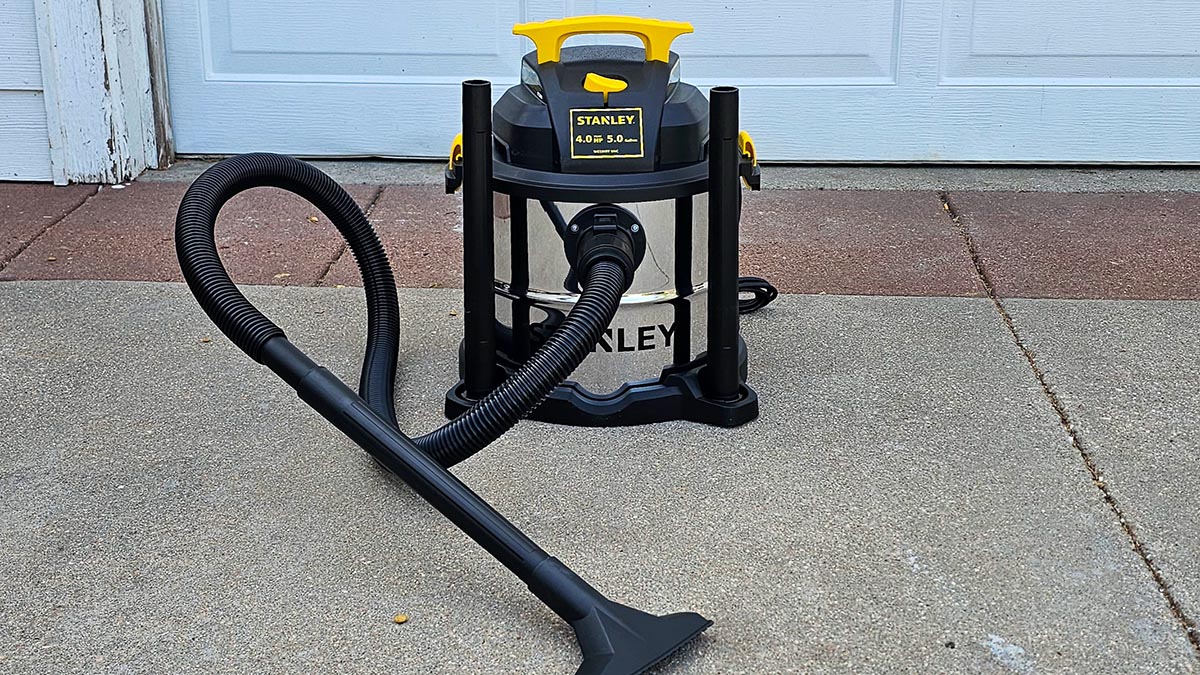
What to Consider When Choosing a Shop Vac
The most crucial factor to consider when shopping for a shop-type vacuum is its intended use. If you use it on the jobsite, you’ll probably want to choose one with a large tank and robust motor. A smaller model or a cordless shop vac might do if you’re looking for one to clean up occasional small messes.
Capacity and Power
Capacity relates to the vacuum’s tank size. While there are no hard and fast rules, small-capacity models have the smallest tanks (1 to 5 gallons) and are generally best suited for limited household messes. Medium-capacity vacs average 6- to 10-gallon tanks and are well suited for jobsites and busy DIY projects. The largest-capacity tanks (over 10 gallons) are usually limited to dedicated shop use since their size makes them less portable.
Power in a corded shop vacuum is rated by horsepower, and many of today’s top models have 4 hp or higher motors. Cordless vacuums are rated by voltage, and 18 to 20 volts is average for most. However, you can also find 12-volt models as well as more powerful models.
Corded vs. Cordless
Both types have benefits, but as manufacturers continue to improve their rechargeable batteries, cordless models are becoming increasingly popular. The upside of cordless vacuums is easy to recognize: You are not limited by the length of an extension cord, and you can use the vacuum in a remote spot.
The downside is that the batteries on cordless models require recharging. Still, if you can remember to recharge the batteries when they run low, you’ll have instant power and you won’t be tripping over a cord.
Hose and Attachments
Having a long hose on a shop-type vacuum makes reaching all the nooks and crannies in your workshop easy. About 5 to 8 feet is standard for a hose, but some models come with extra-long hoses of 10 feet or longer. Remember, longer hoses can be unwieldy when you’re trying to wind and store them. Still, if you use a corded vacuum in your shop, you may prefer a long hose.
Hoses also come in various diameters, from 1.25 inches on small shop vac units to 2.5 inches, which are common on larger, heavy-duty models that are ideal for picking up bigger chunks of debris.
Shop vac attachments range from a single utility tool or crevice tool to several extension wands, a floor nozzle with a squeegee for cleaning up water, utility nozzles, and even brush nozzles. On the DeWalt 9-gallon model we tested, we were tickled to find an accessory bag that snapped onto the side of the vacuum to hold all its accessories.
FAQs
Shop-type vacuums come in a handful of different styles. You can find wall-mount shop vac models for the garage, which are always handy for use as a car vacuum. If you’re looking for a quiet shop vac, you may want to consider a battery-powered model with a low decibel rating. Here are some of the more common questions and their answers.
That depends on several factors, including quality, how they’re used, and how often you use them. We’ve had shop-type vacuums that lasted 10 years, but we’ve also had a couple that didn’t last a year. Look closely at consumer ratings for a good idea of how long a specific model will last.
It’s certainly more powerful, and if you need to vacuum up water as it runs into your home, it will be more efficient than a lower hp model. However, if you only use it to clean up small messes infrequently, a lower hp model will often be quieter, smaller, and still effective.
For general use, vacuum hoses made from polyethylene (PE) or polyvinyl chloride (PVC) are fine. They’re also the most common. You can find hoses made from thermoplastic rubber or polyurethane (PU) for industrial use. If you plan to use the vacuum to suck up still-warm (not hot) ashes, you’ll want a special ash vacuum designed to withstand heat and a metal-reinforced hose.
Meet the Tester
Glenda Taylor is a product tester and writer specializing in the construction, remodeling, and real estate industries. She tests a wide range of power tools as well as other home improvement, household, and lawn-and-garden products.

